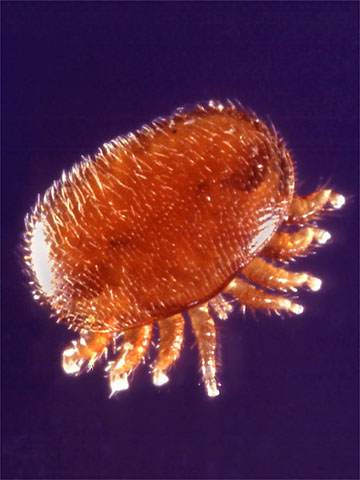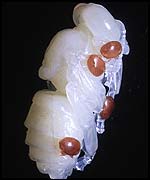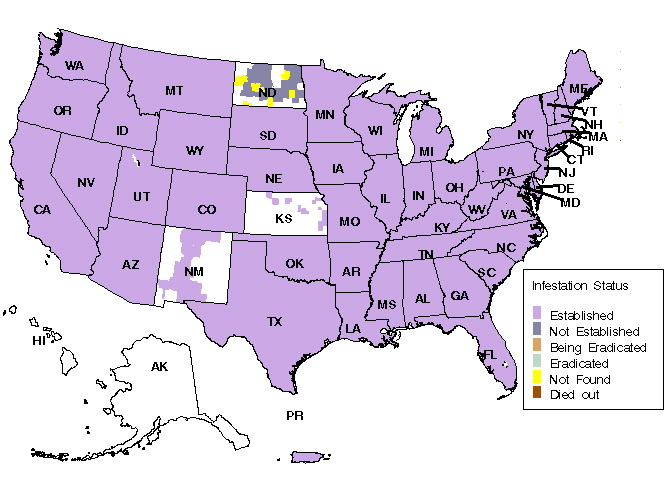Scientific Name: Varroa destructor
Classification:
Phylum or Division: Arthropoda
Class: Arachnida
Subclass: Acari
Order: Parasitiformes
Family: Varroidae


(S. Bauer, ARS/USDA) (BBC)
Identification: The
adult female varroa mite has a
reddish-brown, oval body about 1.1 mm long and 1.7 mm wide. The
male mite is smaller, with a yellowish, spherical body approximately
0.8 mm in diameter. Females of the closely related species Varroa jacobsoni (which has yet to
infest European honeybees) are markedly smaller than V. destructor.
The varroa mite is almost exclusively found as a parasite on
honeybees. Females lay their eggs in uncapped brood cells, and
the young feed on developing bees. An inspection of a hive's
brood cells is thus the most reliable means of detection. Female
mites also parasitize adult bees, hiding in between the insects'
first abdominal segments. A number of methods are used to detect
varroa infestations in adult bees. The most popular involves
collecting a large number (300-500) of bees in a glass jar, spraying
them with ether, and shaking the jar vigorously (30-50% of the mites
will release and stick to the walls of the jar). A less
destructive and possibly more efficient method, the "sugar shake", uses
powdered sugar, which purportedly interferes with the adhesive used by
the mite to attach itself to its host.

(Purdue Center for Environmental and Regulatory Information Systems)
Current Distribution: V. destructor has spread to <>every continent<> except Australia and is widely distributed throughout world apiculture, absent only in Australia, Hawaii, and central Africa. Although they have recently been found on other insects (including the bumblebee Bombus pennsylvanicus), varroa mites can only reproduce when associated with honeybees and thus are considered harmless to <>other insects.
Site and Date of Introduction: Varroa mites were first found on imported European honeybees (Apis mellifera) in Hong Kong and Singapore in 1963 and spread through Asian apiculture of this species over the next decade. They appeared next in various countries in Europe and South America in the early- to mid-70's. A single mite was discovered in Maryland in 1979; however, no more were seen in the U.S. until populations were discovered in Wisconsin and Florida in 1987.
Mode(s) of Introduction: The host shift from Asian to European honeybees first occurred when Apis mellifera was brought East for apiculture and presumably came into contact with Apis cerana. These "introduced" European honeybees were then purportedly taken from Asia back into Eastern Europe by amateur beekeepers in the Russian Army, bringing the parasite with them. Subsequent introductions into other continents and areas are also assumed to have occurred via the shipping of bees for apiculture.
Reason(s)
Why it has Become Established: Apiculture provides an ideal
situation
for the establishment and persistence of a parasite like the varroa
mite.
Honeybees are raised in very high-density hives, allowing for similarly
high densities of mites. Because of this, commercial beehives can
maintain extremely damaging infestations that would normally run their
course quickly in most populations. It is hypothesized that the
slower development of Apis mellifera
relative to Apis cerana also
contributes to a faster growth of infestations (as the female is given
more time to lay more eggs on the developing larvae). Once it has
become introduced in a region, the mite spreads quickly between bee
colonies, giving it access to many novel infestation sites. It is
thought that contact between drones outside of their respective hives
is responsible for this spread, though transport on secondary hosts
such as the bumblebee may also be a factor. Unlike a bacterial or
viral epidemic, the spread of varroa does not necessarily spread
immunity in its wake, and only a few resistant strains of A. mellifera have been identified,
leaving most commercial bees open to re-infestation even if they have
already been treated for varroa. Finally, although control is
possible in commercial hives and much money and effort has been spent
in extirpating apicultural infestations, the mite has spread to wild
honeybees which are not as tightly controlled, providing a reservoir
for re-infestation of cultured bees.
Ecological
Role: V. destructor is a
parasite, and thus may serve some role in population control of wild
bees. In its original host, the partially resistant Asian
honeybee, the mite causes much less mortality than in its introduced
hosts, suggesting that the original host-parasite relationship was more
stable and normalized.
Benefit(s): Varroa mites could possibly be used as a biological control mechanism for introduced honeybees, and are already decimating feral populations in the Americas. However, some of the more worrisome strains, such as the Africanized "killer" bee, show resistance to varroa infestation.
Threat(s): Varroa mites are extremely damaging to honeybee colonies. While the mites alone may cause some mortality by simply feeding off of larvae and adults, they mainly kill by acting as disease vectors for native infections like acute paralysis virus and Paenibacillus larvae. They spread these agents in a manner similar to the mosquito, transferring bodily fluids from one host to the next. By crippling adults and killing potential workers at the larval stage, varroa infestation weakens the colony, leaving it open to conquest by other colonies or the eventual death of the infested colony due to lack of maintenance. In temperate climates, varroa mite infestation typically kills an entire colony within three to four years, though in warmer areas such as Florida death can occur within seven months. The loss of cultured bees is a serious economic burden for the apiculture industry because of both loss of honey for sales and increased spending on control. The loss of feral and native honeybees in the Americas and Europe (respectively) through varroa infestation has been even more pronounced than in apiculture, with up to 90% of wild colonies lost in some areas and local extirpation possible in more isolated ecosystems, such as the British Isles. While less immediately economically damaging than infestation among cultured bees, loss of the plant species pollinated by these bees is potentially a much greater disaster for both agriculture and biodiversity.
Control Level Diagnosis: Highest Priority: Rampant spread of Varroa destructor threatens to seriously undermine both the apiculture industry and the biodiversity of areas in which honeybees are pollinators.
Control Method: Many commercial methods are available for the control of varroa infestations in commercial hives. A number of chemicals are available, the most popular of which is Apistan. Mites can quickly develop resistance to chemicals, however, and concerns over the contamination of honey often lead to the use of chemicals only when honey is not being produced. Less noxious methods, such as herbal remedies, mineral oil treatments, biological control by fungi, and the newly developed electric "mitezapper", can be used year-round but are not consistently effective. In general, treatment in apiculture usually only occurs once an infection is detected, limiting opportunities for prophylaxis. Resistant strains are being developed, but these are not yet widely used and may serve as reservoirs for the infection of the remaining majority of susceptible bees. Increased use of resistant strains and vigilance on the part of beekeepers in detecting infections early seems to be the best means of eliminating the parasite.For wild bees, control is arguably more important due to the role of these insects in the life cycle of a wide variety of plants. If the mite is successfully eliminated in apiculture, it may prove unable to sustain its virulence in the lower-density populations of wild bees. The stable persistence of the species in its original host suggests this may be the case. If the mite remains prevalent in apiculture or remains virulent in the wild, however, control may still be more selectively applied. Where honeybees are introduced and native pollinators still exist, varroa mites may prove an effective means of eliminating the introduced bees. Allowing the mite to persist in certain areas, however, may provide reservoirs for the infection of other bees. Plans have been proposed to introduce resistant strains into areas in which honeybees are required for pollination.
References:
Global Invasive Species Database. "Ecology of Varroa destructor" 2004
(http://www.issg.org/database/species/ecology.asp?si=478&fr=1&sts=sss)
Mid-Atlantic Apicultural Research and Extension Consortium. "Varroa Mites" 2000
Schmitz, J. "Variation in the parasitic bee mite Varroa jacobsoni Oud." Apidologie, 2000
University of Florida Institute of Food and Agricultural Sciences. "Varroa mite" 2000
(http://creatures.ifas.ufl.edu/misc/bees/varroa_mite.htm)
Schmitz, J. "Varroa mite test easy on bees, researchers say" Capitol Press, 2000
Huang, Z. "Mitezapper- A NEW AND EFFECTIVE METHOD FOR VARROA MITE CONTROL", American Bee Journal, 2001
(http://www.mitezapper.com)